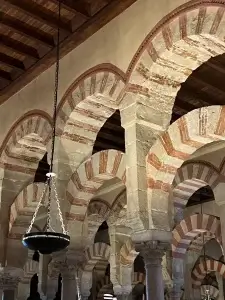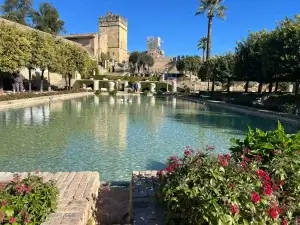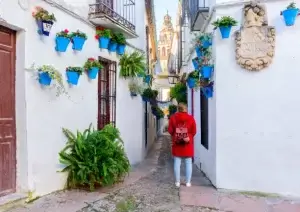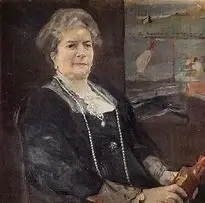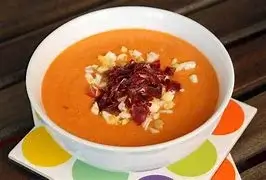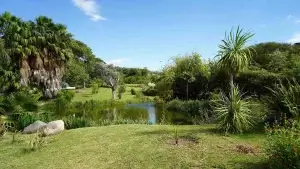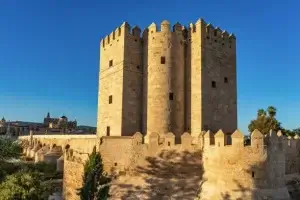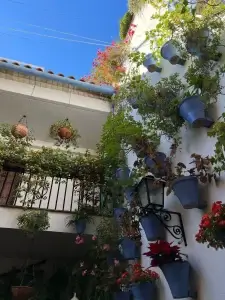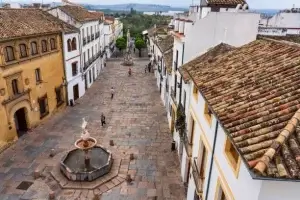Even if you’re just passing through or can’t stay long in Cordoba, this city will captivate you with just a stroll through the city centre. Here’s a brief guide to what you can’t miss on a three-day trip to Cordoba. Check out all our guided tours of Cordoba to make the most of your time.
En este post podrás leer:
Day 1: What you can’t miss on your three-day trip to Cordoba
As soon as you arrive, you’ll probably want to see the most essential and famous sights first, so let’s start there.
The Mosque-Cathedral: A must-see on your itinerary
The Mosque-Cathedral of Córdoba is undoubtedly one of the most impressive and emblematic monuments in Spain. Its unique blend of Islamic and Christian architectural styles reflects the history of the city. What’s more, the contrast in colours, light and style will make you want to stay there for hours. Every detail of this complex makes it even more unique, which is why we invite you to discover it with our guided tour of the Mosque of Córdoba.
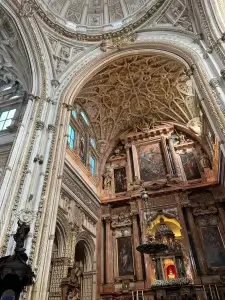
The Alcázar de los Reyes Cristianos and its gardens
The Alcázar of Córdoba has gardens with beautiful fountains, which are undoubtedly a must-see in the city. Its vegetation, the views from the tower, its essence… And if you are accompanied by a good guide who can explain the history behind the Alcázar, it couldn’t be better. That’s why we recommend our monumental tour of Córdoba, so you can enjoy this very special place.

The Jewish Quarter: A stroll through the old Jewish quarter of Córdoba
The old Jewish quarter of Córdoba hides thousands of secrets and stories that you will discover with the help of a guide. Its winding streets enchant everyone who passes through them.
The white walls and the narrow spaces between them make it a very cosy and unique place, enveloping visitors in the splendour of the Jewish quarter. If you want to know more, we will tell you all its hidden stories on our guided tour of the Jewish quarter. The Roman Bridge: A historical monument on your tour
The famous Roman Bridge in Córdoba has more history than meets the eye. Just by crossing it, you realise how many centuries it must have seen. On one side is the Calahorra Tower. On the other is the old town with the Mosque and the Alcázar. If you want to delve deeper into the history of the city, we recommend reading about the famous legends of Córdoba.
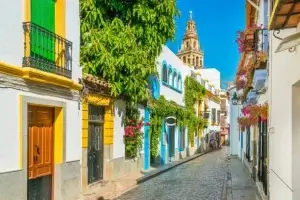
Day 2: Tour of the most modern and vibrant side of Córdoba
In addition to its unrivalled historical past, there is a more modern side that is also worth seeing. Here we showcase the most interesting aspects of modern Córdoba.
The Museum of Fine Arts: A glimpse into the history of art in Córdoba
The Museum of Fine Arts in Córdoba has works that are well worth seeing, in addition to the beauty of the building itself. This museum is home to many important works by prominent Spanish painters. The best-known works are Zurbarán’s ‘The Immaculate Conception’; Goya’s ‘Portrait of the Countess of Lebrija’; ‘The Love of God’, painted by Francisco de Asís; and ‘El Rocío’, by Julio Romero de Torres. These four works alone demonstrate the museum’s artistic wealth. The building dates back to the late 16th century, when it was the Convent of Santo Domingo, and still retains its essence.
Victoria Park and its surroundings
The best-known park in Cordoba is probably Victoria Park. A beautiful natural setting that offers a breath of fresh air away from the hustle and bustle of city life. It is the perfect place for a picnic with friends, a romantic date or a stroll in the shade of the trees.
Plaza de la Corredera: the centre of modern life in Cordoba
Plaza de la Corredera is currently a shopping arcade where you can stop for a bite to eat and try some typical Cordoba tapas. It is a very important hub of city life.
Enjoy the local cuisine in the patios of Cordoba
Córdoba is the Andalusian city with the most popular cuisine. Dishes that are eaten throughout Spain but not everyone knows their origin. Some of our everyday delicacies, such as salmorejo, flamenquín and rabo de toro, are native to this place. Since you are visiting Córdoba, you cannot miss the opportunity to try the original recipe.
If you go a little further afield, you can find the lesser-known ajoblanco. This mixture of flavours is a treat for the palate of anyone lucky enough to try it. For an even more complete experience, book a flamenco tour in Córdoba. For an even more complete experience, book a flamenco tour in Córdoba. Day 3: Córdoba in three days: nature, architecture and traditions

Day 3: Córdoba in three days: nature, architecture and traditions
The Botanical Gardens of Córdoba: a place to relax and enjoy nature
This unique natural area is home to more than 250 species. In addition to its wide variety of fauna, including animals that are not native to the area, giving it a special biodiversity. A visit is also highly recommended for children, as they will learn a lot about some of the species they see every day and others that, if they weren’t there, they might never see. It has a wealth of information about the life it harbours, giving visitors the opportunity to learn new things.
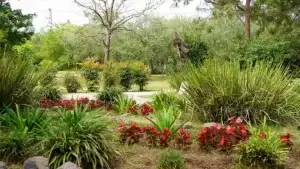
The Calahorra Tower and its museum
The Calahorra Tower is a defensive tower that marks the beginning of the Roman bridge that crosses the Guadalquivir River. It was built in the 12th century by the Almohads, although it was later renovated in the 4th century, giving it its current appearance. Inside, the Living Museum of Al-Andalus tells the story of how three very different cultures coexisted in the city. It also includes a climb up to a viewpoint from which you can enjoy a panoramic view of the entire historic centre. If you are interested in this historical coexistence, you can read about the 5 traditions of Cordoba.
The Patios of Cordoba: A journey through Andalusian tradition
The famous patios of Cordoba are something you simply must see before you leave if you visit during the season. The flowers standing out against the white walls are the essence of Cordoba in its purest form. Each patio is unique, decorated by its residents to their own taste, making each one one of a kind. Let yourself be carried away by its charming streets and experience this tradition, declared Intangible Cultural Heritage of Humanity, through our guided tour of the Patios of Cordoba.
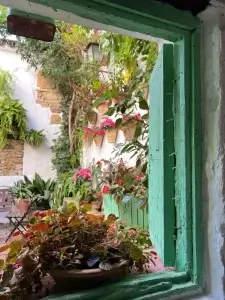
Plaza del Potro: Where history and art meet
This Cordoba square dates back to 1577. At that time, it was a place of trade and lodging, serving as a stopping point for travellers. In those days, the Posada del Potro was very well known and was located right here, where the Fosforito Flamenco Centre now stands. You can also find the Museum of Fine Arts and the Julio Romero de Torres Museum, one opposite the other. Its charming tiled floor, picturesque houses and fountain make this square a very welcoming spot. To end your visit on a different note, you can also join a Segway tour of Cordoba.
Frequently asked questions
When is the best time to visit Cordoba in three days?
Without a doubt, the first half of May. The courtyards are fully decorated, it’s the season of the May crosses and the temperature is pleasant.
What to see in Cordoba in three days if I’m on a tight budget?
If you try to avoid paying for admission to monuments, you can take a stroll through the Jewish quarter, across the Roman Bridge or along the banks of the Guadalquivir River. For added convenience, you can leave your luggage at a luggage storage facility in Córdoba.
How long does it take to visit the Mosque-Cathedral?
There is no set visiting time if you are on your own, so we recommend that you spend as much time there as you like. Although we can tell you in advance, you won’t get tired of being there.
Is it possible to visit Cordoba in three days on foot?
Of course. If necessary, there is also a public bus transport system. We recommend walking around the historic centre of the city and falling in love with the charm of Cordoba.

